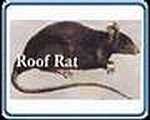Norway and Roof Rats
Rattus
 |
|
Rats are some of the most troublesome and damaging rodents in the United States. They consume and contaminate food, damage structures and property, and transmit parasites and diseases to other animals and humans. Rats live and thrive under a wide variety of climates and conditions; they are often found in and around homes and other buildings, farms, gardens, and open fields. People do not often see rats, but signs of their presence are easy to detect. In California, the most troublesome rats are two introduced species: the roof rat and the Norway rat. It is important to know which species of rat is present in order to place traps or baits in the most effective locations. Norway rats (Rattus norvegicus), sometimes called brown or sewer rats, are stocky burrowing rodents that are larger than roof rats. Their burrows are found along building foundations, beneath rubbish or woodpiles, and in moist areas in and around gardens and fields. Nests may be lined with shredded paper, cloth, or other fibrous material. When Norway rats invade buildings, they usually remain in the basement or ground floor. The Norway rat occurs throughout the 48 contiguous United States. Generally it is founds at lower elevations but may occur wherever people live. Roof Rats. Roof rats (Rattus rattus), sometimes called black rats, are slightly smaller than Norway rats. Unlike Norway rats, their tails are longer than their heads and bodies combined. Roof rats are very agile climbers and usually live and nest above ground in shrubs, trees, and dense vegetation such as ivy. In buildings, they are most often found in enclosed or elevated spaces in attics, walls, false ceilings, and cabinets. The roof rat has a more limited geographical range than the Norway rat, preferring ocean-influenced, warmer climates. In areas where the roof rat occurs, the Norway rat may also be present. If you are unsure of the species, look for rats at night with a strong flashlight or trap a few.
Habits
How to Spot a Rat Infestation Because rats are active throughout the year, periodically check for signs of their presence. Once rats have invaded your garden or landscaping, unless your house is truly rodent proof, it is only a matter of time before you find evidence of them indoors. Experience has shown it is less time consuming to control rodents before their numbers get too high, and fewer traps and less bait will be required if control is started early. Inspect your yard and home thoroughly. If the answer to any of the following questions is yes, you may have a rat problem. Do you find rat droppings around dog or cat dishes or pet food storage containers? Do you hear noises coming from the attic just after dusk? Have you found remnants of rat nests when dismantling your firewood stack? Does your dog or cat bring home dead rat carcasses? Is there evidence rodents are feeding on fruit/nuts that are in or falling from the trees in your yard? Do you see burrows among plants or damaged vegetables when working in the garden? Do you see rats traveling along utility lines or on the tops of fences at dusk or soon after? Have you found rat nests behind boxes or in drawers in the garage? Are there smudge marks caused by the rats rubbing their fur against beams, rafters, pipes, and walls? Do you see burrows beneath your compost pile or beneath the garbage can? Are there rat or mouse droppings in your recycle bins? Have you ever had to remove a drowned rat from your swimming pool or hot tub? Do you see evidence of something digging under your garden tool shed or doghouse?
Habitat
Rats, like house mice, are mostly active at night. They have poor eyesight, but they make up for this with their keen senses of hearing, smell, taste, and touch. Rats constantly explore and learn about their environment, memorizing the locations of pathways, obstacles, food and water, shelter, and other elements in their domain. They quickly detect and tend to avoid new objects placed into a familiar environment. Thus, objects such as traps and baits often are avoided for several days or more following their initial placement. While both species exhibit this avoidance of new objects, it is usually more pronounced in roof rats than in Norway rats. Both Norway and roof rats may gain entry to structures by gnawing, climbing, jumping, or swimming through sewers and entering through the toilet or broken drains. While Norway rats are more powerful swimmers, roof rats are more agile and are better climbers.
Threats
Prevention:
Repair or replace damaged ventilation screen around the foundation and under eaves. -Provide a tight fitting cover for the crawl space. Seal all openings around pipes, cables, and wires that enter through walls or the foundation. Be sure all windows that can be opened are screened and that the screens are in good condition. Cover all chimneys with a spark arrester. Make sure internal screens on roof and attic air vents are in good repair. Cover rooftop plumbing vent pipes in excess of 2 inches in diameter with screens over their tops. Make sure all exterior doors are tight fitting and weatherproofed at the bottom. Seal gaps beneath garage doors with a gasket or weatherstripping. Install self-closing exits or screening to clothes dryer vents to the outside. Remember that pet doors into the house or garage provide an easy entrance for rodents. Keep side doors to the garage closed, especially at night.


